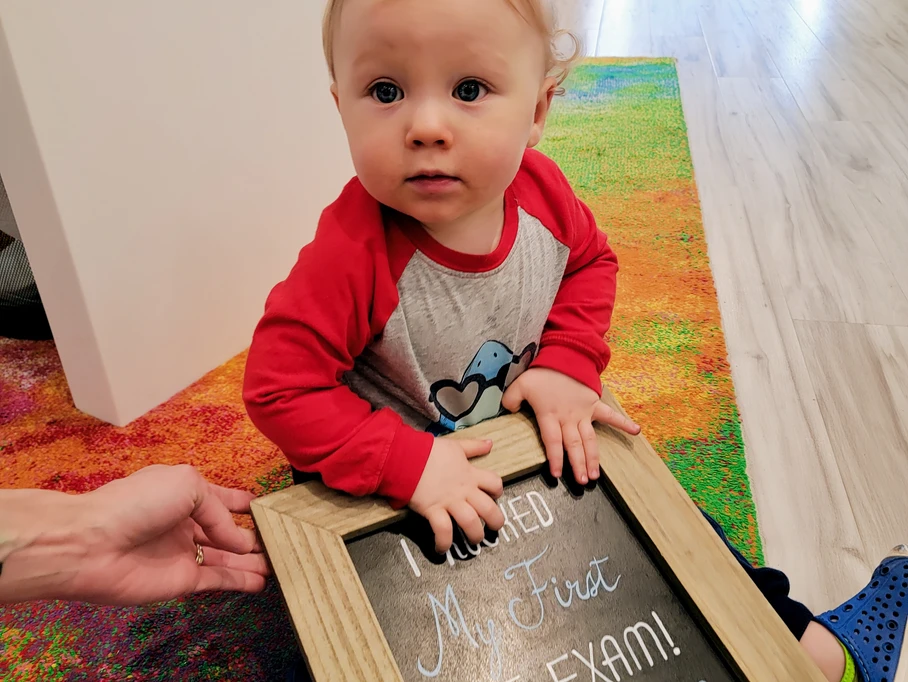As a mom, I know that there can be a lot of questions about your little one, so I thought I would put together a quick guide about your little guy or gal’s eyes and vision development.
Let’s start from the very beginning…
Birth to Four Months:
From birth to four months your little ones’ eyes are in focus at 8 to 10 inches in front of them. This just happens to be the distance to your face when you are holding them in your arms. And let’s face it, you are their whole world at this point. As they get older, their focal point gradually moves further and further away.
Also, their eyes will not appear coordinated for the first couple of months of life, and this is completely normal! As they get older, their eye coordination improves and their depth perception develops.
Babies colour vision is not fully developed until four months of age. The retina has two types of photoreceptors that help us see: rods and cones. The rods are in charge of our vision in low light situations and the cones are in charge of our colour vision. The cones do not fully develop until four months of age. At first your baby will be drawn to high contrast patterns. This is why a lot of toys for younger babies are coloured black and white.
At birth, your child’s lacrimal gland is not fully developed, so they do not produce tears. It takes one to three months for the gland to fully develop and tears to be produced.
Five to Eight Months:
This next phase of vision development is all about depth perception. Depth perception allows your baby to judge if objects are further or closer from one another. Your baby’s eyes will become increasingly coordinated together, leading to better eye-hand coordination. Crawling can start around eight months, which further develops eye-hand-foot-body coordination.
Nine to Twelve Months:
The milestones continue through nine to twelve months of age. Some highlights include:
- At nine months, babies start to pull themselves up to a standing position.
- At ten months, babies grasp objects with their thumb and forefinger.
- At twelve months, most babies will be crawling and trying to walk.
You now might be wondering, when should you bring your little one in for an eye exam?
The first eye exam is recommended at six to nine months of age! At this appointment, the goal is to determine if there is anything that would prevent your baby’s eyes from developing properly.
We want to rule out that three main things:
- That there is no eye turn or strabismus present.
- That there is not a strong prescription in one or both eyes.
- That there is nothing blocking the light from getting into the eye. Also to rule out any presence of eye disease.
If any of these conditions are missed it could cause amblyopia. Amblyopia means that even with the correct prescription, the eyes are not able to see properly due to the connections between the eye and the brain not developing properly. In other words, amblyopia means that the eyes and brain are not working together properly, causing decreased vision.
Sometimes in order to figure out if your child needs glasses, an eye drop is used to completely relax the focusing system. This allows the doctor to figure out what the true prescription is and to prescribe the correct glasses, if necessary. The side effects of the drops include blurry vision, (especially up close), and light sensitivity. These side effects are temporary but can last for up to 24 hours. Sunglasses are recommended to make your little one more comfortable after this test.
Sometimes eye exams on babies and kids go really well and other times they are more challenging. That’s OK! We always do our best to get the information we need. But if we cannot get it all on the first visit, we will do a follow up at a later date to get everything we need. Each time your child comes to our clinic we get more and more information. They get more and more comfortable as well. At the Kennedy Eye Clinic we try to make eye exams fun. At the end of the visit your little one can take a picture with our first eye exam sign, and of course they get a prize!
We cannot wait to see you and your little one for their first eye exam! Stay tuned for more useful information on kids’ eyes and vision development.
– Dr. Anna Matiko



